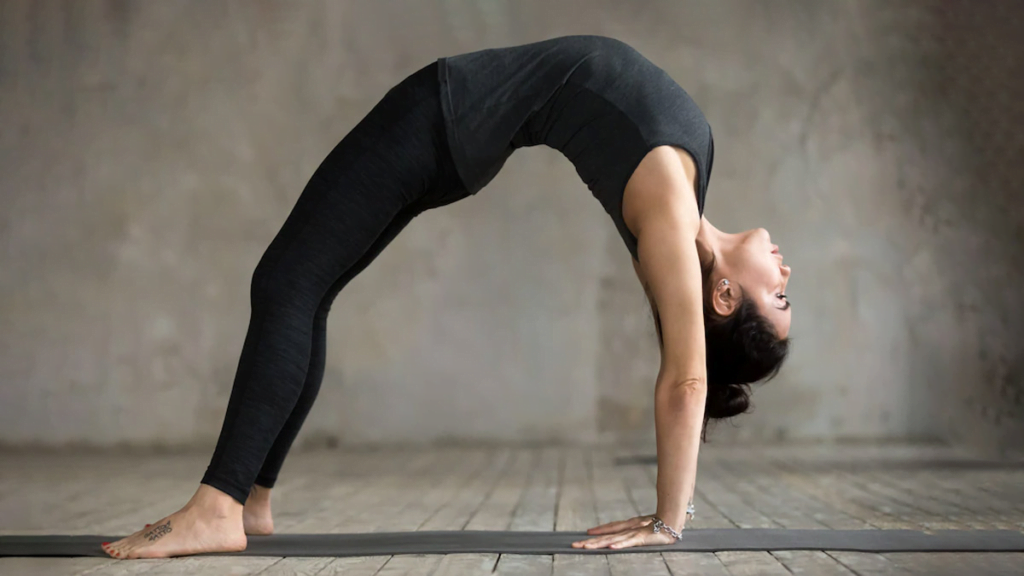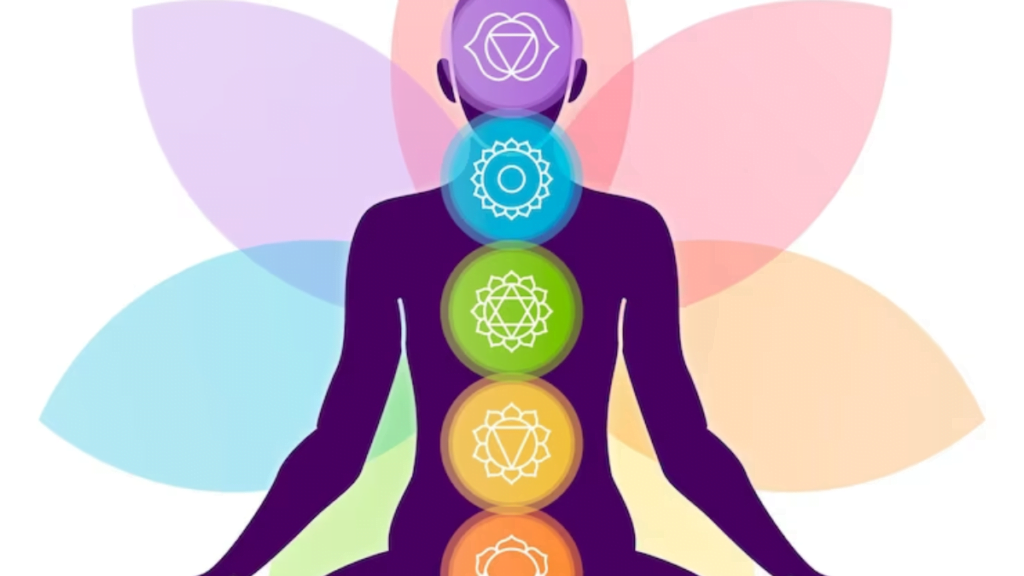Chakrasana: Introduction
Chakrasana, also known as the Wheel Pose, is a popular yoga asana that offers a myriad of benefits for the mind, body, and spirit. Derived from the Sanskrit words “chakra” meaning “wheel” and “asana” meaning “pose,” Chakrasana represents the opening and energizing of the seven chakras in the body. In this article, we will explore the step-by-step guide to performing Chakrasana, its benefits, modifications for beginners, and advanced variations.
Understanding Chakras
Chakrasana: Before diving into the practice of Chakrasana, it’s essential to understand the concept of chakras. Chakras are believed to be energy centers within the body that correspond to different physical, emotional, and spiritual aspects of our being. There are seven main chakras aligned along the spine, each associated with specific qualities and characteristics.

Preparing for Chakrasana
Chakrasana: Before attempting Chakrasana, it’s crucial to warm up the body adequately. Engaging in a series of gentle stretches, such as Cat-Cow pose and Bridge pose, can help loosen the spine and prepare the body for the deeper backbend of Chakrasana. It’s also advisable to practice under the guidance of a qualified yoga instructor, especially if you’re a beginner.
Table of Contents
Step-by-Step Guide to Performing Chakrasana
- Start by lying on your back with your knees bent and feet hip-width apart, close to your buttocks.
- Bend your elbows and place your palms beside your shoulders, fingers pointing towards your feet.
- Inhale deeply and press into your palms and feet to lift your entire body off the mat, coming onto the crown of your head.
- Exhale and straighten your arms, lifting your head off the mat and arching your back.
- Keep your thighs and inner feet parallel, engaging your leg muscles.
- Maintain the pose for a few breaths, keeping the weight evenly distributed throughout your body.
- To release, exhale and slowly lower your back, one vertebra at a time, onto the mat.
Chakrasana: Benefits
Chakrasana offers a wide range of benefits:
Stretches and Strengthens: Chakrasana provides an intense stretch to the entire front of the body, including the chest, abdomen, and hip flexors. It also strengthens the back, shoulders, and arms.
Improves Spinal Flexibility: The deep backward bend of Chakrasana enhances the flexibility of the spine, Improves Spinal Flexibility: The deep backward bend of Chakrasana enhances the flexibility of the spine, promoting better posture and relieving tension in the back.
Boosts Energy and Vitality: Chakrasana stimulates the flow of energy throughout the body, revitalizing and rejuvenating the practitioner.
Opens the Chest and Lungs: By expanding the chest, Chakra-sana increases lung capacity and improves respiratory function.
Tones the Abdominal Muscles: The engagement of the core muscles in Chakra-sana helps strengthen and tone the abdominal region.
Enhances Digestion: The gentle compression applied to the abdominal organs during Chakra-sana stimulates digestion and aids in detoxification.
Relieves Stress and Anxiety: The practice of Chakra-sana releases tension and stress, promoting a sense of calm and relaxation.
Boosts Self-Confidence: As a challenging pose, mastering Chakra-sana builds self-assurance and fosters a sense of achievement.
Chakrasana: Common Mistakes to Avoid
While practicing Chakrasana, it’s important to be aware of common mistakes that can compromise your safety and effectiveness:
Lack of Warm-up: Skipping proper warm-up exercises can increase the risk of injury. Always warm up the body before attempting Chakra-sana.
Forceful Entry or Exit: Avoid forcefully entering or exiting the pose, as this can strain the neck, shoulders, and spine. Move with control and grace.
Collapsing Elbows: Keep your elbows firm and avoid collapsing them outward, which can strain the wrists and shoulders.

Overarching the Neck: Maintain a neutral alignment in your neck and avoid excessive arching, as it can strain the cervical spine.
Tensing the Glutes: Relax your buttock muscles and focus on engaging the core and leg muscles instead.
Modifications for Beginners
Chakrasana: modifications can help you gradually
Supported Bridge Pose: Practice Bridge pose with a block or bolster beneath your sacrum to gradually open the chest and shoulders.
Wall Assisted Chakrasana: Stand facing a wall and place your palms on the wall at shoulder height. Walk your feet closer to the wall and gently arch back, using the wall for support.
Half Wheel Pose: Lie on your back and place your hands beside your shoulders, fingers pointing towards your feet. Press into your hands and lift your head and shoulders off the mat, keeping your hips grounded.
Tips for Practicing Chakrasana Safely
- Listen to your body and respect its limits. Avoid pushing yourself too far or forcing the pose.
- Warm up adequately before attempting Chakra-sana to prepare the body for the backbend.
- Engage your core muscles and legs to maintain stability and balance throughout the pose.
- Breathe deeply and evenly, allowing the breath to flow freely in and out of your body.
- Practice Chakra-sana on a non-slip surface to ensure stability and prevent accidents.
- If you have any pre-existing medical conditions or injuries, consult with a healthcare professional before attempting Chakra-sana.
Incorporating Chakrasana into Your Yoga Routine
Chakrasana can be incorporated into your regular yoga practice to enhance flexibility, strength, and overall well-being. Here’s how you can include it:
- Begin with a gentle warm-up, including Cat-Cow pose and gentle backbends like Sphinx pose.
- Progress to Bridge pose to Progress to Bridge pose to further warm up and open the chest, shoulders, and hips.
- Practice a few rounds of Sun Salutations to further prepare the body and build heat.
- After the Sun Salutations, move into a sequence of standing poses like Warrior II, Triangle, and Extended Side Angle to strengthen and energize the body.
- Transition to seated poses such as Boat pose and Cobbler’s pose to continue engaging the core and opening the hips.
- When you feel adequately warmed up and prepared, move into Chakra-sana. Follow the step-by-step guide and focus on proper alignment and breath awareness.
- After practicing Chakra-sana, allow your body to cool down with gentle forward folds, twists, and a relaxing Savasana (Corpse pose).
- Remember to always listen to your body and modify the practice as needed. Each individual is unique, and it’s important to honor your own limitations and progress at your own pace.
Chakrasana and Spiritual Connection
Chakrasana is not only a physical pose but also holds spiritual significance. As the name suggests, Chakra-sana aims to awaken and balance the seven chakras, which are believed to be vital energy centers in the body. The pose stimulates the flow of prana (life force) and allows it to move freely, promoting a sense of harmony and alignment between the physical, emotional, and spiritual aspects of our being. Through regular practice, Chakra-sana can deepen your spiritual connection and enhance your overall sense of well-being.
Chakrasana and Physical Well-being
From a physical perspective, Chakra-sana offers numerous benefits. The deep backbend stretches and strengthens the entire front body, including the spine, chest, abdomen, and hip flexors. This can improve posture, alleviate back pain, and enhance overall flexibility. The pose also stimulates the digestive organs, boosts metabolism, and improves circulation, leading to better digestion and detoxification. Regular practice of Chakra-sana can help tone the abdominal muscles, improve lung capacity, and increase overall vitality and physical well-being.
Chakrasana for Mental Health
In addition to its physical benefits, Chakra-sana has a positive impact on mental health. The pose requires focus, concentration, and balance, which can help quiet the mind and promote mental clarity. As a backbend, Chakra-sana opens the chest and encourages deep breathing, which has a calming effect on the nervous system. This can reduce stress, anxiety, and depression, and promote a sense of inner calm and emotional balance. Regular practice of Chakra-sana can uplift the mood, boost self-confidence, and enhance overall mental well-being.
Chakrasana and Energy Flow
Chakrasana is closely associated with the concept of energy flow in yoga. The pose is believed to activate and balance the flow of prana (energy) throughout the body, particularly along the spine where the major chakras are located. When the chakras are aligned and energy flows freely, it is said to promote vitality, health, and a sense of inner harmony. Chakra-sana helps to remove energetic blockages, awaken dormant energy, and create a state of balance and harmony within the body-mind complex.
Advanced Variations of Chakrasana
Once you have mastered the basic Chakra-sana, you can explore advanced variations to deepen your practice and further challenge yourself. Here are a few examples:
One-Legged Chakrasana: From the full expression of Chakra-sana, extend one leg straight up towards the ceiling while keeping the other leg grounded. This variation adds an extra challenge to your balance and core strength.
Eka Pada Urdhva Dhanurasana: Begin in Chakra-sana and then bend one leg at the knee and reach for the foot with the opposite hand. Extend the other leg straight up towards the ceiling. This advanced variation increases the intensity of the backbend and requires greater flexibility and strength.
Chakrasana on Forearms: Instead of placing the palms on the ground, lower down onto the forearms while keeping the chest lifted. This variation challenges the strength of the shoulders and forearms and allows for a deeper opening of the chest.
Chakrasana with Straight Legs: Once you feel comfortable with the traditional Chakra-sana, you can attempt the pose with straight legs. This variation intensifies the backbend and further strengthens the core and leg muscles.
Remember to approach these advanced variations with caution and only attempt them when you feel ready. It’s essential to listen to your body, work within your limits, and seek guidance from a qualified yoga teacher if needed.
Conclusion
Chakra-sana, or the Wheel Pose, is a powerful yoga asana that offers numerous physical, mental, and spiritual benefits. By practicing Chakra-sana regularly and mindfully, you can improve spinal flexibility, strengthen the body, enhance energy flow, and experience a deeper connection with yourself. Remember to approach the pose with patience, respect your body’s limitations, and seek guidance from a qualified yoga instructor. Embrace the journey of Chakra-sana and enjoy the transformative effects it can have on your overall well-being.
You can also read
- What is Shariah Compliant Investment? 2023
- Company Setup in Australia 8 Best Ways for Newcomers
- Burn Injury Lawyer : What You Must Understand in 2023
Frequently asked questions
Is Chakra-sana suitable for beginners?
Chakra-sana can be challenging for beginners due to its deep backbend. It’s advisable to build a strong foundation in basic yoga poses and gradually work towards Chakra-sana under the guidance of a qualified instructor.
Are there any precautions to consider before practicing Chakra-sana?
Individuals with neck or spine injuries, high blood pressure, or any medical condition should consult their healthcare provider before attempting Chakra-sana. It’s important to practice with awareness, listen to your body, and modify the pose as needed.
Can Chakra-sana help with posture correction?
Yes, Chakra-sana can help improve posture by opening the chest and strengthening the back muscles. Regular practice can promote better alignment and reduce slouching.
How long should I hold Chakra-sana?
Start with holding Chakra-sana for a few breaths and gradually increase the duration as you build strength and flexibility. Aim for a comfortable length of time without straining yourself.
Can Chakra-sana be practiced during pregnancy?
It’s generally recommended to avoid deep backbends like Chakra-sana during pregnancy. However, consult your healthcare provider and a prenatal yoga specialist for personalized guidance.
Don’t forget to support us by following us on Google News or Returning to the home page TopicsTalk
Join Telegram and WhatsApp for More updates
Follow us on social media




